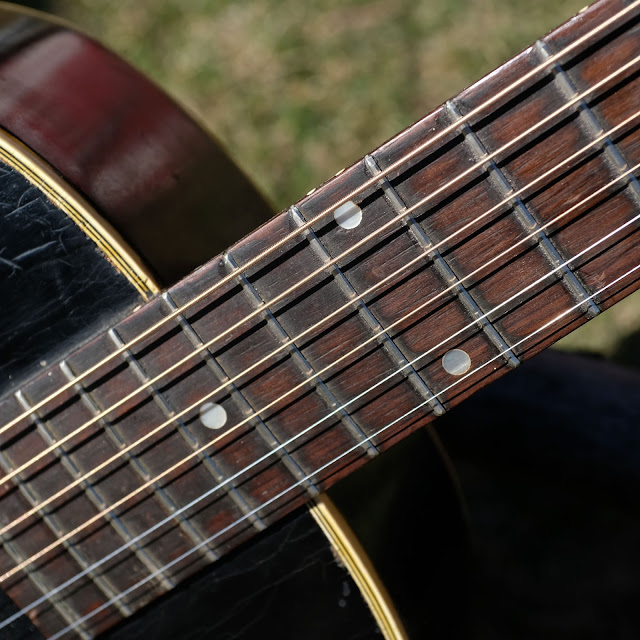1942 Gibson L-0 Flattop Guitar
I think it's safe to say that this is an objectively great guitar. It has a ton of punch, plenty of mids and clarity, a good, thick, growly lower-mids/bass, and a full-sounding treble. It's like it was tailor-made for old-time backup work. Bass-run work and treble-fill noodling sounds perfect. You don't have to work hard to get a lot of sound out of this. I like.
It is, however, really beat-up! The guts were all there, however, when it came in -- though it was (and in some ways, still is) filthy. It's still mostly original and it's quirky as all heck -- it has a solid spruce top, solid maple sides, and a solid mahogany back. The neck is mahogany and the original board and bridge are rosewood. I replaced said bridge (it was entirely-split-up) with a new rosewood one, however. These materials basically make this guitar a slightly-less-fancy L-00.
My work included a fret level/dress, bridge replacement, many crack repairs/cleats/fills to the back and one to the top, brace reglues to the top and two finger-brace (short, ~3" ones) replacements, new bone saddle, new ebony pins and endpin, replacement (same-period) vintage tuners, a new bone nut, and a new (cut from old tortoise celluloid) truss rod cover. It plays bang-on and feels great. The neck is straight, the frets have decent life left to them (though they're the old, small, Gibson stock), and the truss rod works perfectly. I barely have it engaged.
Specs are: 24 13/16" scale, 1 3/4" nut width, 1 1/2" string spacing at the nut, 2 1/16" spacing at the bridge, medium-C neck profile with ~12" radius on the board, 14 5/8" lower bout width, 10 1/8" upper bout, and 4 3/8" depth at the endblock.
There's a replacement section of fretboard that was clumsily-installed many years ago right behind the nut. I cleaned it up a bit and trimmed it to its proper length (which I measured off of a same-scale Gibson in the shop).
The firestripe pickguard is tres cool. It has two small holes in it that were patched in ages-past. I think someone was attempting to screw in a loose finger-brace below it. Said brace was missing before I replaced it during repairs.
The original celluloid binding around the soundhole had a tiny missing spot which I replaced. I also scraped much of the top binding just a bit here and there to reveal its nice, multi-ply appearance that was covered by black paint.
Note that the original finish has wear and tear that's evident everywhere. It's a wartime instrument that's been through the war.
My new replacement bridge is rosewood with a drop-in saddle rather than straight-through. This is easier to use for incremental action adjustments. I also added string-ramps and the pearl dots are just inlaid -- they don't cover bolts as in the original design.
You can see the only crack in the top just in front of the bridge at the low E string side.
My new bridge is actually a tiny-bit thicker top-to-bottom than the original and has the same saddle profile as the original -- with a little over 1/16" room for adjustment.
The back has numerous crack repairs. The ones that are tidy are my work. Unfortunately, there's a gloppy, gross-looking ancient repair on the lower-bout-back. Everything has been cleated on the inside for stability.
These tuners are unoriginal to the guitar but period spec and vintage. This came with some "wonderful" bottom-drawer Chinese tuners installed.
The back of the neck has been loved!
The inside back is pretty dingy and had tons of dirt/dust that's somewhat-melded into it. Here's an example of one of the many cleats I added to the back.
The H-suffix factory order number suggests 1942 based on the rest of the design elements on this guitar -- and the fact that this was the last year of production for this model.
Just for kicks, here's the guitar in a different setting.
































Comments